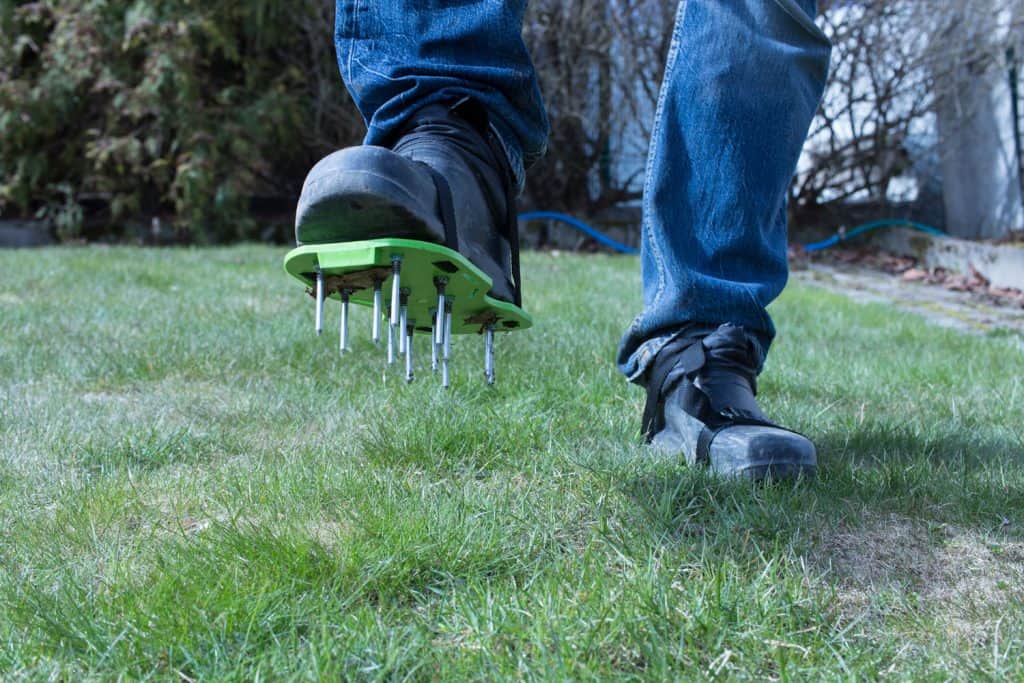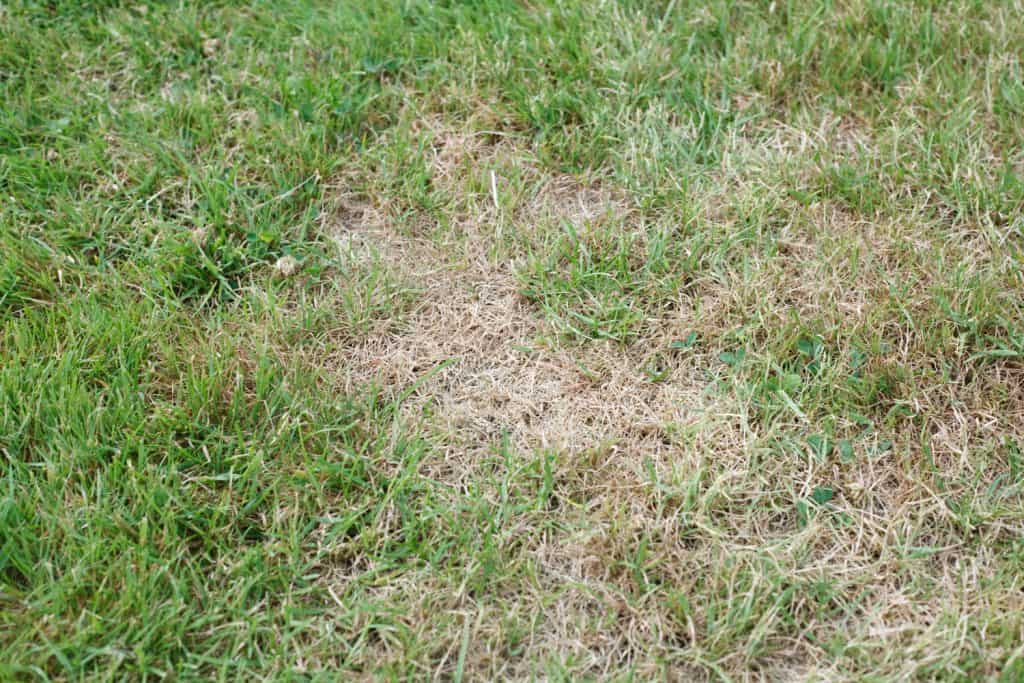Did you just aerate your lawn in the last six months? Have you noticed some discolored areas in your otherwise green lawn? Or maybe some puddles have been forming on the lawn after a rainstorm? Perhaps you noticed your neighbors working on their lawn maintenance and saw them aerating? We've researched how often to aerate your lawn to shed some light on the best lawn maintenance routine.
Your lawn should be aerated once a year. Your lawn needs nutrients, water, and air to maintain a healthy ecosystem. Over time, your lawn gets compacted down, reducing adequate intake of the nutrients, water, and air it needs. Aeration helps open up the compacted soil to increase the absorption of these three necessities. This results in a healthy, lush green lawn.
Now that you have a basic understanding of what aeration does and why it is needed, continue reading to find out just how to aerate your lawn. We will also have an in-depth look at some other common questions about aeration.

Why should you aerate your lawn?
Aerating loosens the soil and aids in managing the thatch or layer of dead grass.
Additionally, aerating:
- Increases nutrient absorption
- Benefits the PH
- Helps the lawn to grow thicker
- Reduces water runoff
- Prepares the grass for winter dormancy
You should be aerating your lawn annually at a minimum. If you have a lawn that is in rough shape with heavy thatch build-up, discoloration, and puddles, you will want to aerate twice a year until your lawn improves. Then reduce it back to annually.
Testing Compactedness
To test the soil compactedness, you will want to grab a screwdriver or other metal object. Push the screwdriver into the soil. If the screwdriver goes into the soil with ease, then your soil is not compacted. If the screwdriver is difficult to push into the soil, that is a sign aeration is needed.
Soil compaction affects the root growth of your grass. When you have heavily compacted soil, it makes it difficult for the roots to absorb water, keeping them shallow and thus reducing the growth of the grass.
When to aerate
For annual aeration, it is best to aerate in the fall. September and October are ideal. November and December are still ok for aeration, but you will want to aerate prior to the first freeze and snowfall of the year. Once it freezes or snowfall occurs, the ground is too hard for aeration, and the grass won't be able to recover.
If your soil is heavily compacted, it may be necessary to keep a routine of aerating twice a year. If aerating twice a year, it is best to aerate in the early spring and fall.
How to aerate
There are multiple options available to aerate your lawn. You can choose to get a mechanical aerator; these come as a push model or a tow-behind model you can attach to a riding lawnmower.
Check out this towable aerator on Amazon.
There are also specific compact aeration machines available for purchase or rental at most home improvement stores.
Check out this push aerator on Amazon.
The last option is simple aeration shoes. Many advise against the aeration shoes unless you have a very compact small lawn as it takes a lot of labor and time to aerate with shoes.
Check out these aerator shoes on Amazon.
To aerate your lawn, you will want to follow these steps:
- Water your lawn the day or two prior to performing the aeration. You will want to soak the lawn thoroughly.
- Make sure to note any areas containing sprinkler heads or other objects you will want the aerator to avoid.
- Aerate the lawn.
- Apply a generous layer of grass seed.
- Most experts recommend after aeration to fertilize and seed the lawn for best results. You will want to water the lawn for a good 15 minutes to set the seed and fertilizer.
- After setting the seed down, avoid mowing for the first two to four weeks to allow the grass seed to establish roots.
Here is a helpful video on aeration:
Should you mow before or after aeration?
You should mow your lawn before aeration. This cuts back the excess grass and helps the soil absorb the water you apply prior to aeration. This, in turn, helps the aeration method penetrate the soil resulting in more efficient and effective aeration, maximizing the results.
Should you water your lawn prior to aeration?
You will want to water your lawn a day or two prior to aeration. You want the soil to be moist but not wet, and you definitely do not want dry soil. If the soil is soaked or totally dry, the machine will not properly aerate.
Which is better: spike or plug aerator?

Plug aerators remove small plugs of soil as they aerate from the root zone. This improves the structure of your soil and is best for compacted soil.
The best time to aerate with a plug aerator is during the peak growing period as not to stress the grass too much. That means early spring or fall for your cool-weather grasses. Aerate in late spring or early summer for your warm-weather grasses.
Spike aerators don't disturb the soil too much and can be used any time of the year. Depending on what you are after determines which aerator is a better fit.
If you just want simple aeration and don't have heavily compacted soil a spike aerator will be fine. If you really need to improve on the soil structure, it is best to go with a plug aerator.
How many times should you aerate your lawn a year?

If your lawn looks brown, has a heavy thatch layer, or you notice thinning areas, you will want to aerate twice a year until the lawn improves. Experts recommend both spring and fall for lawns in these conditions. Once the lawn has improved and looks healthier, you can reduce the aerating to once annually.
If you are just maintaining a healthy lawn, annual aeration along with seeding and fertilizing should be perfectly adequate to maintain the health of your lawn.
Can you aerate your lawn too much?
You can't really over aerate your lawn. However, if you choose to aerate more than twice a year, it can become a case of wasted labor with a diminished return. Once adequately aerated, the soil can only improve so much.
You really shouldn't need to aerate more than once annually if your lawn is looking healthy anyway. It's important to finish your aeration routine with fertilizer and grass seed for best results.
What time of year should you aerate a lawn?
The best time of year to aerate your lawn is when it's at a peak growing period. That way, after you aerate, the lawn has a chance to recover quickly, dispersing the root growth and allowing for sufficient absorption of the excess nutrients and oxygen.
Early spring or fall works best. If spreading grass seed, you will want to make sure to aerate in the spring, so the grass seed has the full summer and adequate time to grow, thickening your lawn.
Is it OK to aerate the lawn in summer?
Aerating in the summer months can work for certain grass types. You will want to make sure you know your specific grass type. Depending on the grass, warm weather grasses for example (common in the Southeastern United States), can benefit from summer aeration.
Warm weather grasses include:
- Bermuda
- Zoysia
- Buffalo
- Bahiagrass
- Carpetgrass
- Centipede Grass
- St. Augustine
If you have cool weather grasses, common in cold weather climates, aerating in the summer won't necessarily kill the grass but it will put unnecessary stress on it which will result in unhealthy looking grass. These cool-weather grasses respond best when aerated in the fall or early spring.
Cool-weather grasses include:
- Kentucky Bluegrass
- Tall & Fine Fescues
- Ryegrass
- Bentgrass
If using a simple spike aerator or aerator shoes you can aerate anytime you would like. This doesn't disturb the soil structure too much and will not put any stress on the grass.
Does lawn aeration really work?

Many people tend to think lawn aeration is a gimmick or unnecessary. It really is not a gimmick and is very beneficial for the lawn. It is a highly effective way to reduce soil compaction and increase nutrients in the grass, thus resulting in a green, thick, healthy lawn. Though it is important to fertilize and spread grass seed after the aeration as the final steps in your lawn care maintenance.
In Summary
We hope after finishing this article you have a better understanding of lawn aeration along with how, when, and why to aerate. If you have not been aerating your lawn on an annual basis, we highly recommend adding it to your lawn care checklist for fall or early spring!
If you enjoyed this article consider these for further reading:
Is Wood Ash Good For Lawn Grass?



